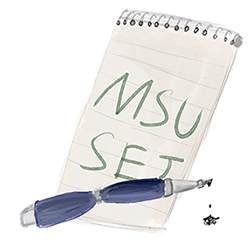 By Shealyn Paulis
By Shealyn Paulis

Shealyn Paulis
This is the 4th in a series of articles about reporting skills by Knight Center students who attended the 2025 Society of Environmental Journalists conference.
Reporters working in or focusing on the Amazon rainforest are forced to take extreme safety measures while doing so. That’s because their coverage threatens industries seeking to exploit the region’s resources and populations.
At the 2025 conference of the Society of Environmental Journalists in Tempe, Arizona, this topic was presented by representatives from the nonprofit organization Brazilian Association of Investigative Journalism (Abraji); security manager Valeria Oliveira and project coordinator Reinaldo Chaves.
The panel was hosted in two languages, Portuguese and English, and was part of an effort to answer why journalists in certain regions, like the Amazon, are put into such dangerous positions and how those threats are combated in the field.
Attendees were guided through a presentation on how Abraji funds, trains and mentors reporters investigating environmental crimes in the Amazon, leading to eight successful investigations thus far. Their organization advocates transparency and prioritizes journalists’ ability to have creative freedom to deliver the stories they want, but reinforces that physical security is the most important aspect of their work.
Latin America is the most dangerous place in the world to be an environmental journalist, according to a 2022 study by the international organization Committee to Protect Journalists.. The Amazon region is under particular stress, according to Reuters. In the past decade, over 200 incidents against journalists, such as threats, kidnappings and murders, have been documented.
Oliveira and Chavez identified key problems that both threaten the environment of the region and those who cover it; Violence against Indigenous people and environmentalists, fires, illegal mining, deforestation and fishing, land grabbing, drug/wildlife/timber trafficking and the climate crisis.
In both languages, panelists described how these problems range. Certain regions face particular problems, like border regions. Different governments bring changing concerns, from corrupt state intervention to locals looking to protect illegal practices, such as mining and drug trafficking.
“As journalists, we need to cover these problems,” said Chaves. “But usually, in the Amazon, this coverage brings the [attention] of the state or police. Also illegal fishers, miners, drug traffickers and hitmen are huge concerns for doing investigations in some areas of the Amazon.”
A translator with Abraji translated for Oliveira.
“It is always dangerous to be a reporter in the Amazon.” She said, “In the city and in the countryside, there are different kinds of dangers. In the city, there are politicians, but in the jungle there are others.”
The panelists offered supplementary materials throughout their presentation.
Included were multiple examples of stories that received their mentorship or funding.
They also provided an example of their detailed security plan, which is an example of a field plan for a journalist during an investigation. A sort of game-plan, this document shows how they detail their trips: listing trusted local contacts, locations of hospitals and police stations, safe ways of communicating (such as messaging in code and using secure apps) and specifying pre-agreed upon meeting points/times.
They additionally provided general tips for supporting journalists, such as training reporters in using risk assessment and how to connect with local sources safely.
One strategy their organization employs is a multi-mentor method, which ensures every mentee is paired with at least one other journalist to edit their work and mentor their safety during investigations, with every article having three mentors.
“After a journalist is selected, they are trained.” Chaves said, “They are given a mentor who specializes in the Amazon, not only in security, but also as a technical mentor.”
During a time where environmental journalists in the Amazon region face great personal risk, Abraji representatives stress that strict safety protocols, funding and intensive training are necessary adaptations for the future of the career. They concluded with a message: protecting the story means first protecting the storyteller. Their complete presentation and all supporting materials can be found here.
